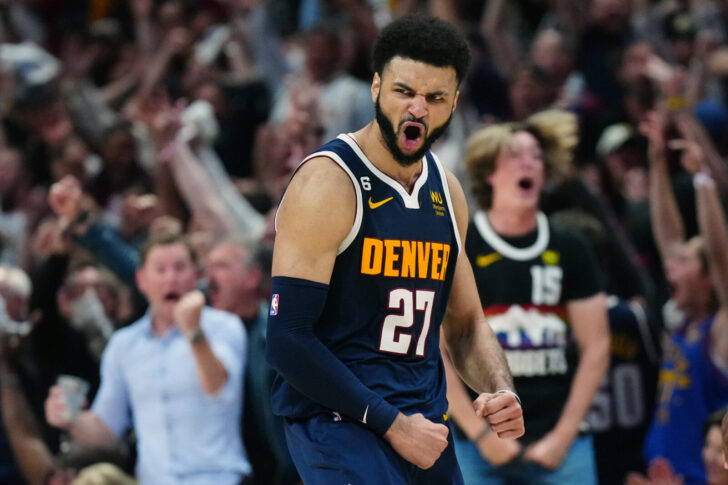Strike 1: It’s no secret that the national media is more than a couple steps behind in their ongoing analysis of the Denver Nuggets playoff series with the Los Angeles Lakers. Seems like after every game they’re finally figuring out something the locals have known all along.
But there’s one thing they’ve yet to come to grips with: The entire altitude factor.
Sure, the talking heads mention it, and they acknowledge that opposition teams often struggle with it when they play at this elevation. But if they’d been paying attention to, say, Major League Baseball players like Hall of Fame pitcher John Smoltz, they might realize that the effects of the thin air don’t simply vanish when a team plane departs DIA.
Baseball players know it. Back in 2012, Smoltz was interviewed on a local radio show, and said this: “When you go to Colorado, your breathing is affected. You feel like you’re out of shape, like you’re holding your breath. What you end up doing is throwing the ball harder, spinning it tighter, and you do things that are going to have a carryover effect to make you sore.”
The first part everyone understands. But the second part, about the carryover effect, is something very few seem to recognize.
When the Lakers came to Denver to start this series, it wasn’t a one-game stopover during a regular season road trip. The two-games-in-three-days format was essentially just like an MLB team that comes to town for a three games series at Coors Field and leaves with that lingering soreness.
This fact is completely lost on the talking heads, who gushed about the Lakers being “refreshed” and “energized” when they returned to LA for Game 3 just two days after dropping the second game in Denver.
They were wrong. Again.
As Smoltz and others could have predicted, the Lakers – who rely heavily on the 38-year-old legs of LeBron James – weren’t refreshed. They were still dealing with the after effects of 5,280 when the Nuggets – the deeper and better conditioned team – took an early lead, forced the home team to play catch up all night and pretty much snatched LA’s will in the fourth quarter. The Lakers tank was on empty down the stretch when Nikola Jokic picked up where Jamal Murray left off and Denver poured in 35 in the final period to take an insurmountable 3-0 series lead.
It bears repeating: Some of the finest and fittest athletes in the world come to Colorado to train at high altitude to get in supreme physical condition. And during the grind of a long postseason, that ends up being a huge benefit to teams like last year’s Stanley Cup champs and this year’s NBA title favorites.
The Nuggets are the better team across the board, and they’re most certainly the best conditioned team left in the postseason. The lesson here should be that the altitude isn’t something to be afraid of if you’re the home team. It’s a valuable ally.
Strike 2: In their 30th season, the Colorado Rockies may actually see a first.
Elias Diaz could give the guys at 20th and Blake the first All-Star catcher in team history.
Every MLB team gets at least one representative on every All-Star team each season, so even when they’ve been bad, the Rockies have had someone wearing purple pinstripes take part in the Mid-Summer Classic. That includes pitchers – German Marquez was the rep two seasons ago – and every other position (not counting designated hitter) on the field, except catcher.
Galarraga. Helton. Walker. Cargo. Tulo. Nolan. Charlie. D.J. And many more.
But never a catcher.
Diaz could change that. Even after the Rockies were bludgeoned three times in Texas, Diaz brought home a .326 batting average, good for third in the National League. He’s provided a number of key hits in recent weeks as the Rockies have tried to climb back near .500 after a horrible start. Defensively, Diaz has thrown out 11 of 25 would be base stealers, which is an excellent percentage even if you don’t factor in the larger bases and limited pick off attempts that MLB put in place this year in an effort to jump start the running game. He’s made just four errors, placing him among the best in the NL in those categories as well.
Philadelphia’s J.T. Realmuto, Atlanta’s Sean Murphy and Los Angeles Will Smith are widely considered the best in the league behind the plate, but those teams each have a number of players who will be worthy of All-Star selection at other positions, meaning the minimum one rep-per-team rule could be a deciding factor in Diaz’ favor. At this point, it’s very hard to look at the Rockies roster and point to any other sure-fire All-Star candidates.
The next six weeks will be the deciding factor of course, but if he stays the course, both on offense and defensively, the former Pittsburgh Pirate could make history. Young Drew Romo – currently trying to find his way at Double-A Hartford – may be the backstop of the future at Coors Field, but Diaz could make himself the best catcher the Rockies have ever had by finishing out this season the way he’s started it.
Strike 3: Can there be such a thing as too much winning?
As the metro area expands and the state as a whole continues to see substantial population growth, new high schools are being built and established ones see their enrollment rise. Those in charge of placing Colorado high schools onto level playing fields athletically have to keep a continual watch on these ever changing enrollment numbers, because enrollment is how schools are categorized into levels ranging from 1Class A – 5A and now 6A for selected sports like basketball.
In some cases, like Valor Christian High School for example, the steady rise in enrollment saw the Eagles athletic programs move from 3A – 5A in less than a decade. The school opened its doors to just freshman and sophomores in the fall of 2007 and has since won 44 state championships in multiple sports at three different levels, including the highest level possible.
Valor is an example of a school and a program that has continued to thrive while embracing the challenge of moving up to higher classifications and taking on more difficult competition.
Others have stayed put, resting on enrollment numbers that may rise, but not at a rate that requires that step up. The best current example is Eaton, just north of Greeley.
The population of the Eaton area is growing, albeit not at the same pace as locales closer to the metro area. It wouldn’t be accurate to call Eaton anything like a “suburb” of Greeley, but the surrounding region does have at least nine high schools. Currently the reported enrollment of around 550 students leaves EHS comfortably within the parameters of a 3A school.
But Eaton is a 3A athletic program in that number only. The Reds lead the state of Colorado with 46 state championships – including 2A football this past fall – and that number is certain to climb before the final bell rings on this semester. The top-ranked and so far unchallenged 25-0 Eaton baseball team just posted a pair of 12-0 wins in the regional round of this year’s high school baseball playoffs. They’re a virtual lock to win a third consecutive state baseball championship, which will give them 14 baseball titles overall.
They’ve already beaten their only true competitor, nearby University, twice and are ranked No. 2 overall behind only defending 5A champion Broomfield in Colorado by MaxPreps, which ranks teams without classification. Eaton is the only 3A team in those rankings.
How’s this for domination: Eaton has won via the 10-run mercy rule in 21 out of their 25 games. They’ve already drubbed 4A teams like Roosevelt and Northridge, walloped top-10 3A teams like Bayfield and Delta on their way to posting 10 shutouts – including their last three games. Their best player, Walker Martin, has hit a staggering 19 home runs in just 99 plate appearances.
As all-time great as this Eaton team is – and the Reds are going for a 3A state title three-peat right now – this sure looks like a program that could benefit from a move up to 4A sooner rather than later.
Winning programs are impactful in a number of ways, but embracing stiffer competition matters too. When winning becomes too easy, valuable lessons don’t get learned.




